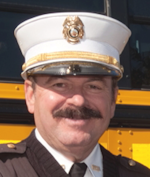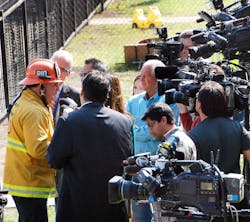PIOs often need to give interviews to the media. Members of the media usually want the “who-what-when-where-why-and-how” of the incident. If you provide that during the interview, it should take care of what they need.
Types of interviews
There are two types of on-scene incident interviews: individual or group. As you probably expect, the individual incident interview is where you are talking to each media outlet separately. This can be a time-consuming endeavor and you have to be careful to deliver the information in the same way during each interview; otherwise, you could change the message. The group incident interview—the one I prefer and consider easier to handle—is where you give an interview to all media outlets at the same time.
Interview locations
Regardless of the type of interview, pick a place where members of the media will be comfortable. They will have various concerns, such as noise (not good for radio outlets) or lighting. The location should also be approved by the incident commanders (IC) to ensure that it does not hamper operations.
The interview location will sometimes be near the incident itself, in some cases, beyond the barricade tape used to keep bystanders out. If this is the case, you should escort the media past the tape to the location where the interview will be conducted. When the interview is complete, they should be escorted back out. Further, advise the media what about any restrictions or limitations related to the interview location. If they are not permitted to leave the area, tell them. If they are permitted some latitude to move about, advise them of the perimeter.
While conducting the interview, use a background that is interesting to the viewer. This may be the incident itself or perhaps one of the responding units on scene. Oftentimes the media will work together—and with you—to determine a background that is satisfactory to all involved.
Setup process
When giving an interview, look professional. You should be wearing a uniform or turnouts. I suggest wearing your helmet, as this is an easily identifiable item to viewers. A note about color: White can be problematic for a cameraperson, as white is used to set up the tones for the cameras. As such, I always keep a black sweater with me for interviews. You could also use a jacket, if it is professional.
While setting up, many of the media will want to hook up microphones on you. They will assist with putting it on and setting it up. Be careful—always assume the microphone is on and anything you say can be recorded. When the interview is complete, be sure to take off the microphone.
Ready to talk
Following camera setup, lightning and sound checks, the interviewer will be ready to start. They will ask you to say your name and spell it. Give the name of your department as well to ensure that your department is getting credit for the interview.
Do not look into the camera. Pick one of the reporters and conduct the interview as though you are talking to them alone. If asked a question by another reporter, you can look at that reporter. Pretend the cameras are not there.
In some cases, you will be asked to do an interview live over the air, talking with the news personalities back at the studio. This is the only time where you want to look into the camera. You will hear the questions over an earphone they provide you. You will also hear the control room or director giving you instructions, such as “you have one minute left.”
Keep sentences short, about 7–12 words each during the interview. Try to leave a three-second silent gap between sentences. This gives the editor back at the station a place to cut and paste your interview.
Think about what you are going to say before you say it. Once you say it, it cannot be retracted. Use simple words that a sixth-grader would understand—not highly technical terms. Do not use words you do not want repeated or used. If you don’t have an answer to a question or need more time to get an answer to a question, tell them you need more time. Never use “no comment.”
When you feel the interview has gone far enough, politely end it. Give them your contact information or provide them with a business card so they can follow up in case they missed something.

Timothy Szymanski
Timothy R. Szymanski is a Master Public Information Officer who is the fire public education & information officer for Las Vegas Fire & Rescue. He has been in the fire service for 51 years and has worked in every position from firefighter/paramedic to fire chief in his career. Szymanski also is a Master Fire Service Instructor. He was inducted into the Nevada Broadcasters Association Hall of Fame in 2017 and received the association’s Community Service Award. Szymanski also received the National Firemark Award from Liberty Mutual Insurance. He is a PIO instructor for the Nevada Department of Public Safety and was the Fire & Emergency PIO for the 1996 Summer Olympics in Atlanta.






